Beef Cattle Feed Requirements Beef Cattle Feed Requirements 6 Months
As ruminant animals, cattle accept a digestive system that allows them to assimilate roughage, like hay and grass, and concentrates such every bit barley grain or dry distillers' grains, through the action of a diverse microbial community in the rumen. Cattle crave free energy, poly peptide, water, vitamins and minerals in suitable amounts to provide adequate nutrition. Requirements will differ depending on the animal's class, age, condition, and stage of productone. Feed costs, including both grazed and conserved feed, are the greatest expense associated with beef cattle operations. Since nutrition is oftentimes the most important factor influencing reproductive performance, managing feed resources at a reasonable price to consistently achieve loftier reproductive rates will assistance ensure profitability for beef cattle operations. In the backgrounding and feedlot sectors, feed costs and feed conversion efficiency significantly touch on profitability. Across all sectors of the beef cattle industry, feed quality, cost, and efficient digestion/absorption/conversion are central factors in beast health, reproduction, performance and profitability.
On this Page
- Key Points
- The Ruminant Digestive System
- Key Nutrients Required by Cattle
- Energy
- Poly peptide
- H2o
- Minerals
- Salt
- Vitamins
- Feed Sources and Quality - Bear upon on Nutrition
- Factors Affecting Nutrient Requirements
- Conclusion
- Definitions
Key Points
- Gradual diet changes (over ii to three weeks) are necessary to allow the rumen microbial population to adjust to changes in the nutrition
- Young, actively growing forages and legume blends can ofttimes meet the nutritional requirements for normal growth and maintenance of cattle herds. Mature pastures, crop residues, or other low-quality forages may take reduced nutritive value, requiring supplementation of protein, energy or additional vitamins and minerals to maintain optimal health
- Energy is necessary for maintenance (feed digestion, cadre trunk functions, and activity requirements) and to back up growth, lactation and reproduction. It accounts for the largest proportion of feed costs and is the nutrient required past cattle in the largest amount
- Neutral detergent fibre (NDF) and acid detergent fibre (ADF) are indicators of the corporeality of fibre in a provender. Higher values indicate poorer digestibility and voluntary intake may be reduced
- Poly peptide is required for maintenance, growth, lactation and reproduction. It is a component of muscles, the nervous system and connective tissue
- H2o is an essential nutrient for cattle, bookkeeping for between 50 and fourscore % of an animal's alive weight. Insufficient h2o intake reduces creature performance faster and more than dramatically than whatsoever other food deficiency
- At least seventeen minerals are required past beef cattle and are divided into two groups: macrominerals and microminerals
- Although minerals are required in minor amounts for optimum beefiness cattle wellness, a deficiency tin can cause significant reductions in growth, allowed role and reproduction
- Mineral needs will vary between herds based on many factors, including water and feed sources, stress, animal type and stage of product. In that location is no "one size fits all" mineral blazon or program
- Mineral toxicity may be indicated by decreased animal performance, anorexia, weight loss and diarrhea
- Vitamins back up many vital metabolic processes in cattle
- Forage is an economical source of nutrients; however, feed quality and mineral content can vary widely, so feed testing and advisable supplementation may be necessary to meet nutritional requirements
- Most forage species have the highest quality at the vegetative stage, when leaves are lush and dark-green, and stems are young and supple. At this stage, these forages may exist able to supply most of the nutrition that the cattle require
- Knowledge of forage quality and animal requirements is necessary to formulate rations that volition back up and maintain a high plane of diet
- Nutritional requirements of beef cattle are influenced by the stage of production
The Ruminant Digestive Arrangement
Ruminant animals take a complex digestive organisation with a iv-chambered stomach. Each sleeping room (reticulum, rumen, omasum and abomasum) plays a part in digesting livestock feeds. Microorganisms colonize the reticulum and rumen (frequently collectively termed the reticulo-rumen) and allow cattle to digest feedstuffs high in fibre, such as grasses, straw and other forages. Balancing the requirements of the rumen microorganisms and the animal is essential for animal functioning.
Cattle take large bites of feed and swallow with trivial chewing. Later, they regurgitate masses of feed back up the esophagus and into their mouths, where it is chewed into smaller pieces and swallowed. This process is known every bit rumination or chewing cud. Betwixt sixty to seventy% of digestion occurs in the reticulo-rumen, which acts like a fermentation vat where bacteria and protozoa convert most of the plant fibre and carbohydrates to acerb, propionic or butyric acid (brusk chain fatty acids) and convert much of the ingested protein to microbial protein. The curt chain fat acids are absorbed through the reticulo-rumen wall and are used as energy in body tissues. Some of the carbohydrate, starch and pectin may pass through the rumen and are then digested in the abomasum and small intestine.
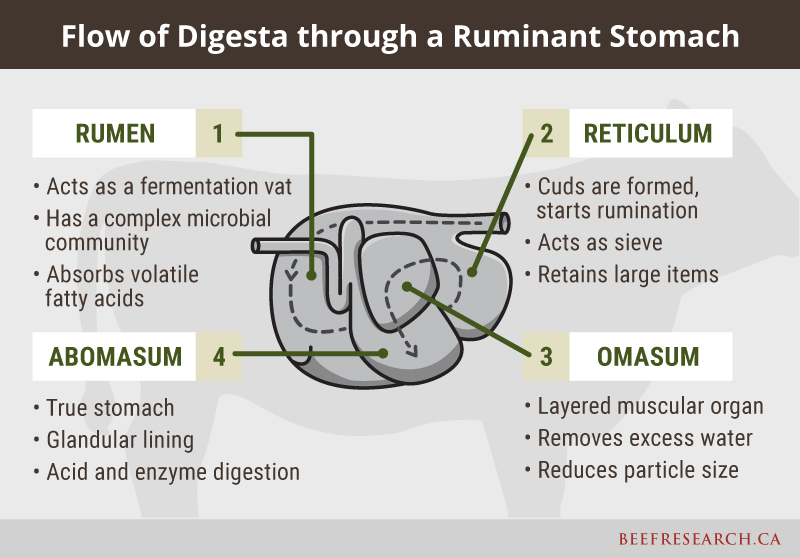
Click to enlarge
Microbes in the rumen require an anaerobic (oxygen free) environment with a slightly acidic pH range (6.five - 7.0), a supply of protein (or non-protein nitrogen) and carbohydrates to feed the microbial population2. The type of feed influences growth of the bacteria. Different rumen microbes adopt unlike types of carbohydrates (starch, cellulose, hemicellulose, starch, and pectin) and will increase or decrease in number depending upon the ratio of different carbohydrates within the diet. Considering the various bacteria and protozoa digest cellulose, hemicellulose and starch differently, sudden changes to cattle diets can touch on rumen activity. For example, a rapid alter to a high energy diet with more grain can result in digestive disorders such as bloat and acidosis. Long periods of acidosis tin can also harm the rumen wall, potentially allowing bacteria to colonize the liver, causing abscessesiii. For these reasons, gradual changes (over ii to three weeks) are necessary to allow the rumen microbial population to adjust to changes in the diet. Nutrients that are not used for the microbes' growth pass out of the reticulo-rumen to supply nutrients for the creature's growth and reproduction.
Key Nutrients Required by Cattle
Young, actively growing forages and legume blends can often come across the nutritional requirements for normal growth and maintenance of cattle herds. Mature pastures, crop residues, or other low-quality forages may have reduced nutritive value, requiring supplementation of protein, energy or additional vitamins and minerals to maintain optimal wellness. Certain nutrients are required in the daily ration, while others can exist manufactured and stored in the body.
Cattle require v key nutrients:
- free energy
- protein
- h2o
- minerals
- vitamins
Energy
Energy is necessary for maintenance (feed digestion, cadre body functions, and activity requirements) and to back up growth, lactation, and reproduction1. It accounts for the largest proportion of feed costs and is the nutrient required by cattle in the largest amount. The components of feed that determine its energy content include carbohydrates, fats and proteins. On a feed test, energy content is usually expressed as full digestible nutrients (TDN); even so, more than precise terms such as metabolizable energy (ME) or net free energy (NE) for maintenance (NEm) or production (NEg) may be preferred by nutritionists. These terms better reverberate the amount of free energy from feed that contributes to animal productivity. Energy deficiency caused by low intake or poor feed quality will limit growth, decrease milk production, reduce torso condition, and (depending on timing and duration) may take negative consequences for reproduction.
Gross energy (GE) is the full corporeality of energy in the feed. Merely non all this energy is available to the animal. Feed energy is lost as it passes through the animal and is excreted as carrion, urine, various gases, and estrus. These losses are a normal upshot of feed digestion and the amount of energy lost at each step differs based on the quality of the feed. Digestible free energy (DE) provides an indication of the portion of energy that the animal can assimilate, with the help of the rumen microbes. Metabolizable free energy (ME) is the amount of energy bachelor to the animal for metabolism and body functions later losses in free energy from rumen fermentation (carbon dioxide, methane) and urine take been deemed for. Net free energy (NE) is the amount that is bachelor to the animal to maintain itself, grow, produce milk and reproduce.
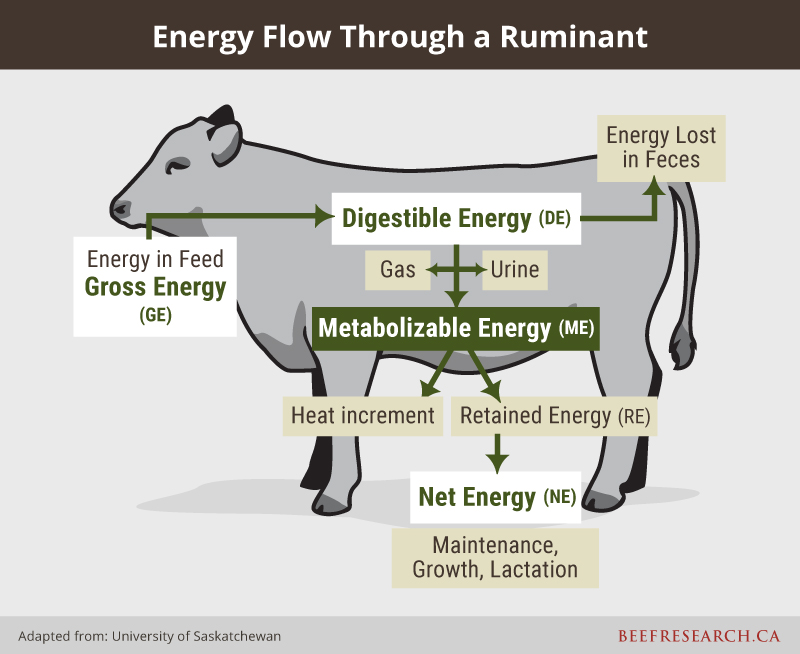
Click to enlarge
Neutral Detergent Fibre (NDF, %) indicates the corporeality of fibre content in the plant. High levels of NDF (above 70%) will restrict animal intake. More mature forages will have higher NDF levels.
Acid Detergent Fibre (ADF, %) measures the least digestible portions of the forage plants, such as cellulose and lignin. Loftier ADF indicates poor digestibility of the feed. High quality legumes generally have ADF values betwixt 20-35%, while grasses can range from xxx-45%.
Neutral detergent fibre (NDF) and acid detergent fibre (ADF) are indicators of the amount of fibre in a forage. Higher values point poorer digestibility and voluntary intake may be reduced.
NDF is a measure of the "bulkiness" of the diet and is mainly hemicellulose, cellulose, and lignin but due to limitations in the analysis it likewise includes a portion of the protein and insoluble ash in the constitute. When NDF increases, animals swallow less. ADF measures cellulose and lignin and is an indication of digestibility and free energy intake. When plants mature, lignin content increases, resulting in higher ADF and reduced digestibility. Feeds high in ADF are less digestible than those high in starches and sugars. The starches and sugars in feed are classified every bit not-structural carbohydrates (NSC). Even in forages, NSC are an important source of energy.
Protein
Protein is required for maintenance, growth, lactation and reproduction. It is a component of muscles, the nervous system and connective tissueane . Protein requirements depend on cattle age, growth rate, pregnancy and lactation condition. Young, growing cattle, as well as those in belatedly pregnancy or lactation, have increased protein requirements.
Virtually protein that ruminants ingest is broken down by the rumen microorganisms and resynthesized as microbial protein. Forages contain rough protein (CP) in ii forms. The greatest portion of protein in fodder is referred to every bit true poly peptide, but forages also incorporate low amounts of non-protein nitrogen (NPN), which rumen microbes tin can use to synthesize microbial protein.
True protein in forages tin can exist further classified every bit rumen undegradable protein (RUP or rumen bypass protein) and rumen degradable protein (RDP). RUP are peptides and amino acids that are digested in the abomasum and absorbed in the pocket-size intestine, while RDP is degraded or broken down by the microbial population in the rumen into ammonia and volatile fatty acids. Microorganisms in the rumen combine the ammonia supplied by RDP or other non-poly peptide nitrogen sources (e.thousand. urea) with rumen digestible carbohydrates to synthesize microbial crude protein (MCP). MCP is digested in the abomasum, with the resultant amino acids absorbed in the small intestine. The corporeality of poly peptide that reaches the modest intestine depends upon the availability of RDP and the rumen digestible carbohydrate. If energy is deficient in the diet, surplus ammonia is converted to urea in the liver and and so lost through urine. If protein is deficient in the nutrition, digestibility of fibre decreases due to diminished microbial activity and musculus volition be degraded to meet the animal'south requirements for amino acids for cadre body functions.
Microbial protein makes upward close to 70% of all protein captivated from the small intestine and the protein contributions from microbes may be shut to 100% for cattle fed low-quality forage.
In almost cow-calf diets, forages with adequate digestibility will provide enough MCP to come across the cows' requirements. Simply, for animals with higher protein demands, like growing calves or lactating cows, it can be beneficial to feed proteins that featherbed the rumen and are captivated in the minor intestine, improving poly peptide bioavailability. Extra protein can be provided past feeds that are high in RUP, similar alfalfa dehydrated pellets, distillers' grains, or culling feeds like canola meal. Nigh forages have higher levels of RDP, specially legumes.
During summer months, while forages and legumes are actively growing, they may supply up to 20% crude protein (CP) with a loftier level of RDP, merely during the winter, protein levels driblet off dramatically. Native pasture, for instance, may test every bit depression as 3-7% CP. Putting upwardly skillful quality feed is fundamental to supplying the beef herd with adequate quality forage sources through the winter4.
Water
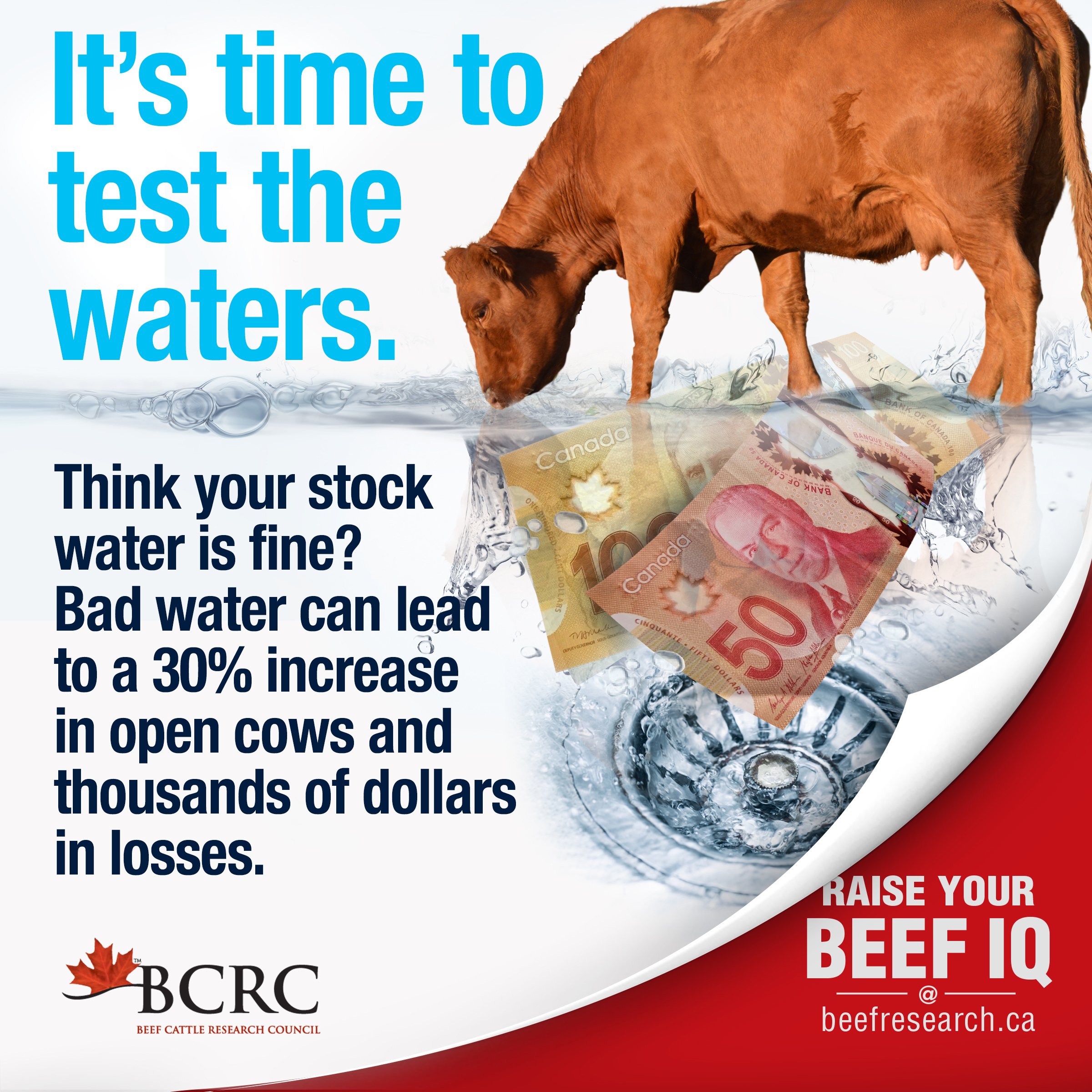 H2o is an essential food for cattle, bookkeeping for between 50 and 80 percent of an animal's live weight. Insufficient water intake reduces animal performance faster and more than dramatically than any other nutrient deficiency. For livestock to maximize feed intake and production, they require daily access to palatable water of adequate quality and quantity. Factors that determine h2o consumption include air and water temperature, humidity, moisture content of the feed/provender, cattle blazon (calf, yearling, bull, cow), the physiological state of the animal (gestation, maintenance, growing, lactating) and water quality.
H2o is an essential food for cattle, bookkeeping for between 50 and 80 percent of an animal's live weight. Insufficient water intake reduces animal performance faster and more than dramatically than any other nutrient deficiency. For livestock to maximize feed intake and production, they require daily access to palatable water of adequate quality and quantity. Factors that determine h2o consumption include air and water temperature, humidity, moisture content of the feed/provender, cattle blazon (calf, yearling, bull, cow), the physiological state of the animal (gestation, maintenance, growing, lactating) and water quality.
Total dissolved solids (TDS) is the chief indicator of water quality and is a measure of dissolved inorganic salts in water. TDS is impacted by high or depression pH levels, sulphates, nitrates, salinity, excessive mineral levels, algae and bacteria. Testing water sources to ensure that cattle have access to adequate amounts of quality water is of import.
The four main functions of h2o in the trunk are:
- to aid eliminate waste products of digestion and metabolism
- a major component of secretions (milk, saliva) as well as individual and fetal growth
- as an aid in body's thermoregulation processes through evaporation of water/sweat from the skin's surface and respiratory tract
- to regulate claret pressure5
Read more than about h2o requirements for beefiness cattle here.
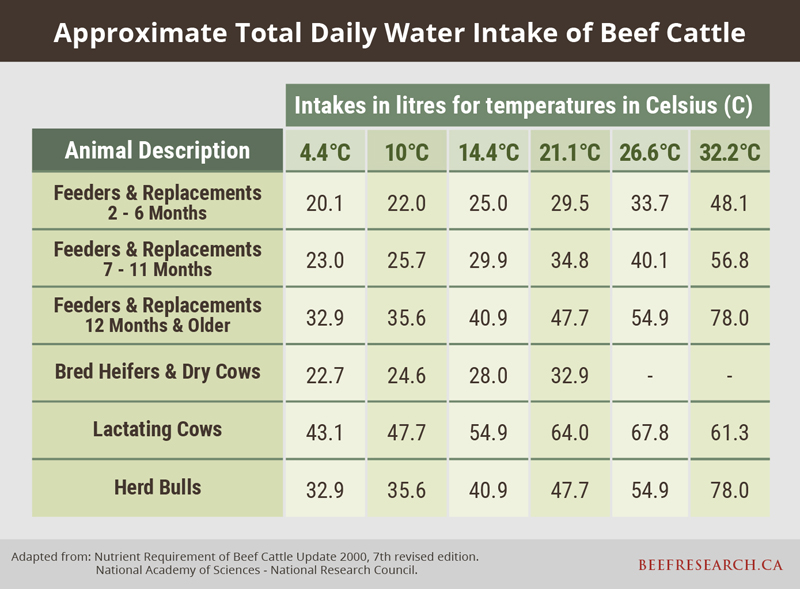
Click to enlarge
Minerals
At to the lowest degree seventeen minerals are required by beef cattle and are divided into 2 groups: macrominerals and microminerals. Macrominerals are those required in relatively large amounts for actual functions, while micro or trace minerals are required in much smaller amounts.
The seven macrominerals required by cattle are calcium (Ca), magnesium (Mg), phosphorus (P), potassium (K), sodium (Na), chlorine (Cl) and sulphur (Due south). Macrominerals are required in amounts over 100 parts per one thousand thousand (ppm) and are often expressed on a percentage (%) dry out matter (DM) ground of the animal's diet.
Beefiness cattle crave ten microminerals, also referred to equally trace minerals. These microminerals, required in relatively small amounts are usually expressed in parts per meg, (ppm) or mg/kg, rather than every bit a per centum of the nutrition. They are chromium (Cr), cobalt (Co), copper (Cu), iodine (I), atomic number 26 (Iron), manganese (Mn), selenium (Se), and zinc (Zn).
Producers strive to provide adequate levels of macro and microminerals without over-supplementing, which increases costs, can create nutritional antagonisms, and increases potential for mineral loss through manure and urine6.
Minerals are required for several functions:
- skeletal development, bone, tooth formation and maintenance (includes Ca, P, Mg, Cr)
- energy, growth, immunity, and reproduction (includes P, Cu, Zn, Mn, Se)
- milk production (includes Ca and P)
- nervous system role and carbohydrate metabolism (Mg, Grand, Na, Cl, South, Co, I, Iron)
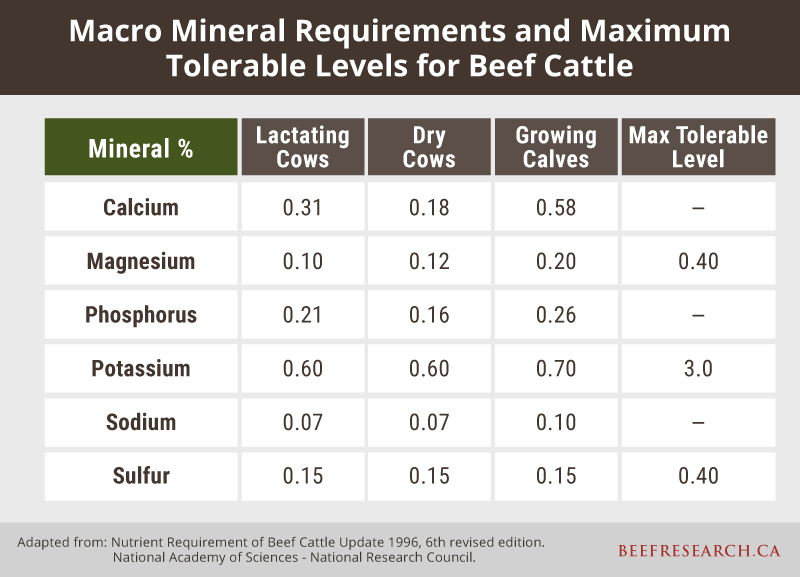
Click to overstate
Although minerals are required in relatively pocket-size amounts for optimum beef cattle health, a deficiency tin cause meaning reductions in growth, immune office and reproduction. The concentration of private minerals in forages varies greatly depending on soil, plant, and management factors. Information technology is of import to include mineral analysis of forages as part of regular feed testing. There are also several interactions that can occur betwixt minerals, vitamins and h2o or feed sources that can limit availability or assimilation. Equally a event, the minerals that are actually available to the cattle may exist much lower than predictable because of these interactions. Even though concentrations found in forages may appear to be sufficient, availability to the animal may exist significantly less. This can crusade deficiencies which may not be noticed by producers until a significant reproductive or health upshot arises.
In this blog, a Saskatchewan producer explains the problems that he experienced with copper deficiency.
Dr. Cheryl Waldner, NSERC/BCRC Industrial Research Chair in One Health and Production-Limiting Diseases, and Professor at the Western Higher of Veterinary Medicine explains that first and 2nd dogie heifers are most likely to exhibit signs of copper deficiency, such as lower conception rates. The toll of open cattle tin quickly impact profitability. Waldner suggests that a properly balanced, palatable mineral mix be offered year-round to ensure optimal herd health and fertility. Recent inquiry in Saskatchewan revealed that forages sampled in bound and fall contained inadequate levels of copper and zinc for beef cows and growing calves in all soil zones. Additionally, upwardly to 43% of the cows involved in the written report were deficient in copper. Producers may detect some early on signs of copper deficiency manifesting every bit a brownish or ruby-red tinge in blackness haired cattle.
Other problems that can arise due to mineral deficiencies include grass and winter tetany, white muscle disease, weak bones, hairless calves, goiter, scours, foot rot, retained placentas, low weaning weights, and reduced fertility.
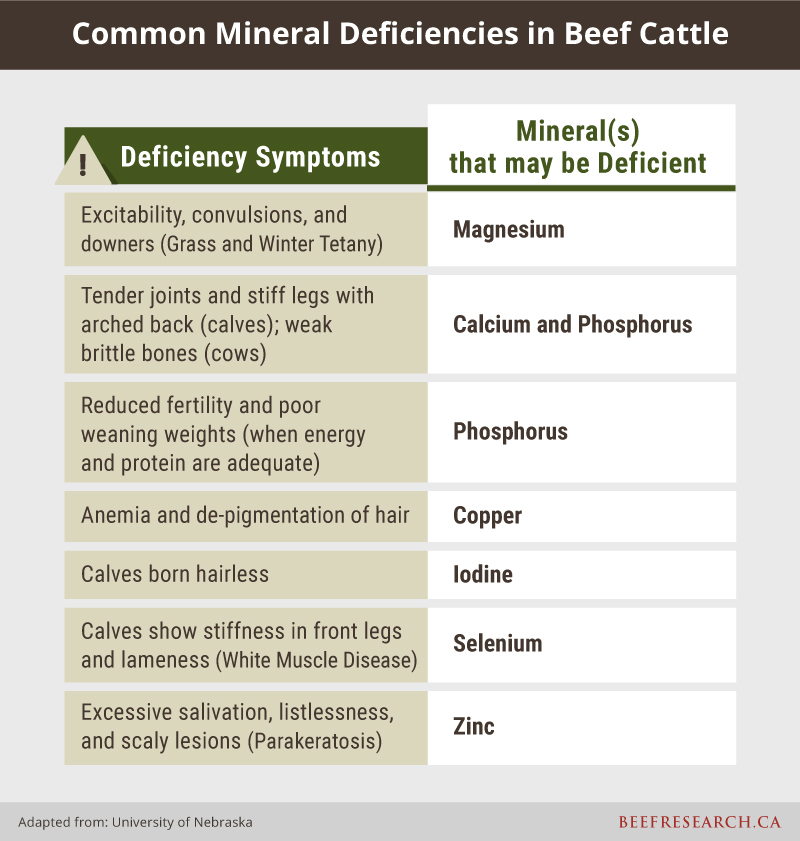
Click to enlarge
Trace mineral supplements are divided into three groups: inorganic, organic and hydroxy trace minerals.
Inorganic minerals are bonded to an inorganic molecule such equally sulphate or oxide. They are usually less expensive but often accept more variability in formulations and are less bioavailable. Inorganic minerals are often a first pick for producers due to affordability but may sacrifice availability and assimilation. The absorption of inorganic mineral from the gastrointestinal tract can be less than v percent7. In certain instances, such as with copper, inorganic minerals may be more than prone to antagonisms with other mineralsviii. Just feeding more inorganic mineral to kickoff these potential issues will not exist successful and may cause more than problems if levels of particular minerals get too high.
- Organic (chelated) minerals are bonded to a carbon containing molecule. These are usually more expensive but take improved assimilation and availability to the brute. Producers generally apply chelated minerals if mineral antagonisms exist in their area, such as loftier molybdenum or sulphur, which reduces copper availability. Chelated minerals are too used when animals are stressed, such as during weaning, or to ensure a high nutritional airplane for procedures such as synchronization or artificial insemination on heifers.
- Hydroxy trace minerals have a crystalline structure that protects metal ions and allows trace minerals to bypass rumen digestion, thereby increasing bioavailability. Often available at a mid-range price, they are being utilized by some producers for cattle in loftier stress situations, such equally weaning or bogus insemination.
With improved trace mineral absorption, producers study heavier weaning weights, increased average daily gain, improved reproductive efficiency, improved calving outcomes, and fewer health problems. Some also report reduced incidence of pinkeye, foot rot, scours and respiratory problems.
Mineral needs will vary betwixt herds based on many factors, including water and feed sources, stress, animal blazon and stage of product. There is no "one size fits all" mineral type or program. Many mineral mixtures are available on the market place, from loose mineral that can be offered free choice or mixed into a ration, to diverse molasses-based lick tubs that comprise vitamins, minerals, and often some protein.
When rations contain grass hay, alfalfa, or a mixture of the two, calcium and phosphorus usually need to be supplemented in a 1:1 ratio (one role calcium to i part phosphorus). When feeding cereal provender rations, such as oat or barley greenfeed, a 2:ane or even three:1 mineral mixture may be required to provide a counterbalanced mineral mixture. Exist sure to consult with a nutritionist to ensure proper supplementation.
Producers must monitor animals for signs of deficiencies or potential toxicity, and work with their veterinarian and nutritionist to ensure acceptable levels and to right any issues. Mineral toxicity may be indicated by decreased animal performance, anorexia, weight loss and diarrhea. Information technology can lead to urinary calculi from excess phosphorus or inadequate calcium to phosphorus ratio, grass tetany from backlog potassium leading to reduced absorption of magnesium, and polioencephalomalacia from excess sulphur. Some minerals such as copper, can go "tied up" or bound to other minerals present in feed and water. In these instances, the mineral volition not exist available to the cattle in the amounts required. If producers are using feed tests to residue mineral needs, animals may even so be deficient due to reduced bioavailability.
An animal'due south diet or ration will decide the blazon of mineral mix required to come across animal requirements. Grass is often low in calcium, phosphorus, magnesium and sodium, while alfalfa or other legumes are generally higher in calcium.
The following label contains the breakdown of a loose mineral that would be considered a 3:i calcium to phosphorus ratio and may exist used by producers feeding cereal greenfeed forages.
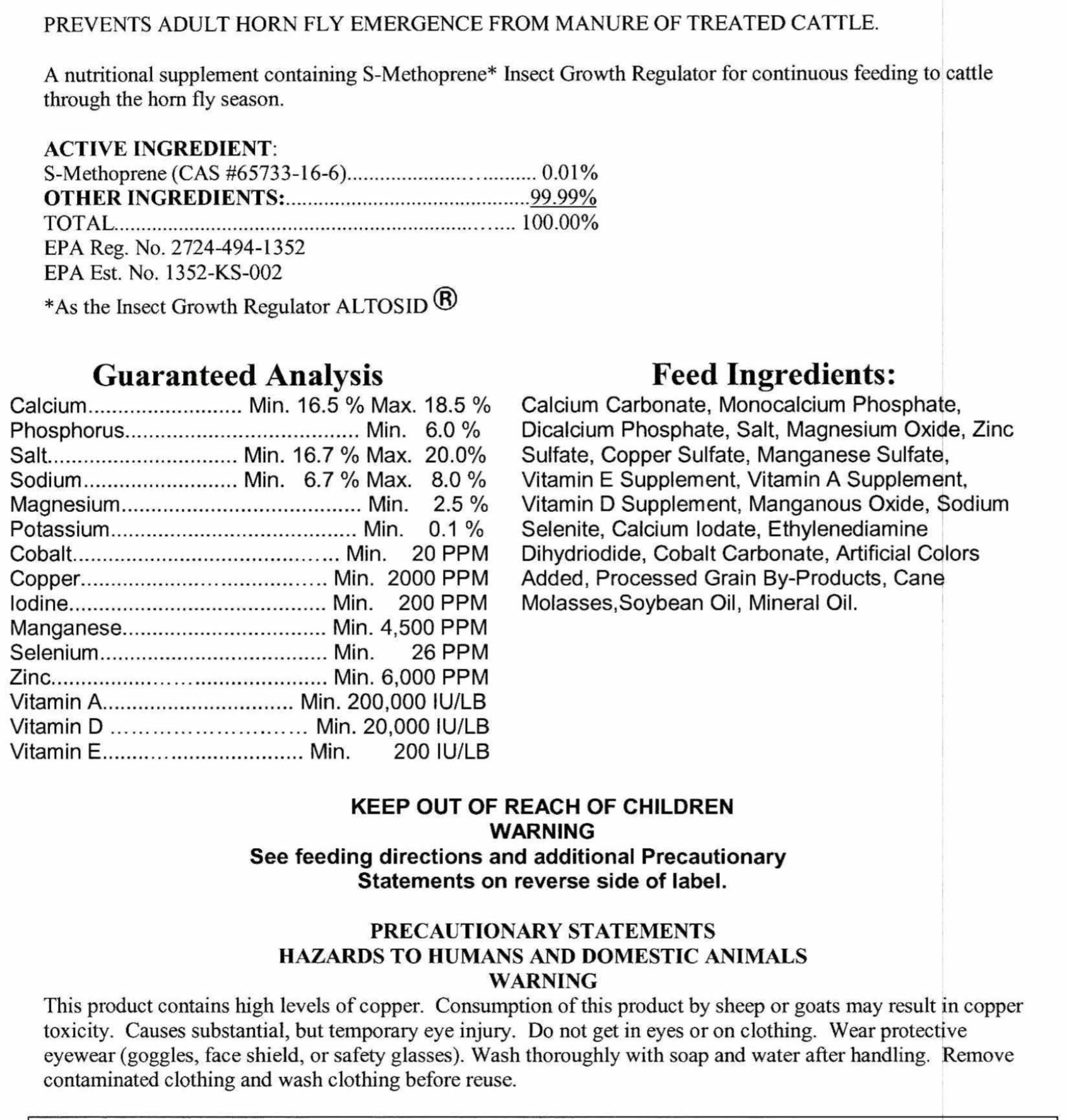
Click to enlarge
Cattle volition oft demonstrate a preference for sure mineral mixes or molasses lick tubs, which tin create challenges in terms of daily intake when feeding free selection. While recommended mineral intake is about threescore grams (ii ounces) per head per day, when fed free option some cattle will over-consume mineral, while others may avert it altogether. Monitor the herd to determine which cattle are frequently at the mineral stations and which cattle may not be consuming adequate amounts. Some producers report better intake when they offer choices of different mineral mixes, such every bit loose and lick tubs. Others report that moving the mineral stations a little farther from water sources to encourage grazing on less utilized areas of pasture caused mineral consumption to drop off slightly.
Ensure that there are enough stations for the number of cattle; a mutual recommendation is ane mineral station for every xx-30 head. When feeding cows with calves at side, more stations may be necessary to ensure that the calves take access, as ascendant, mature cows will often outcompete calves for mineral. When possible, work with a nutritionist to codify an appropriate mineral blend for each operation.
In the following video from Beefiness Enquiry School, Dr. John McKinnon explains what factors producers should consider when designing a mineral program. He as well provides tips for achieving ideal consumption.
Common salt
Examples of salt blocks in diverse formulations. Photo credit Tamara Carter.
Although the salt requirement for beefiness cattle is relatively low, cattle will seek out salt. Loose common salt mixed into mineral blends tin help increase intake to ensure adequate amounts are being consumed. Salt can also be used to encourage cattle to graze underutilized areas of pastures, by placing farther away from h2o and areas where cattle tend to congregate.
Many producers choose an iodized salt block to ensure adequate iodine intake, especially in areas known to take iodine deficient soils. The normal requirement for iodine in a beef cattle diet is 0.v ppm of the total diet and tin usually be provided with iodized common salt blocks. Additional iodine may be necessary if feeding cover crops such as brassicas including turnips, rapeseed or kale which contain compounds that inhibit iodine uptake from the gut. While higher toll, salt blocks that contain trace minerals such as copper, zinc, cobalt and selenium may be used for herds that have experienced bug with pes rot. While these table salt blocks can supply small amounts of certain minerals, additional supplementation with loose or lick tub formulations may notwithstanding be necessary to provide and maintain adequate mineral levels.
Vitamins
Vitamins support many vital metabolic processes in cattle. They are inorganic compounds that are required in small-scale amounts. The historic period and production status of the brute will affect vitamin requirements. Vitamins A, D, Due east and G are fat soluble and are stored in the animal's fatty tissue and liver. Because of this, they practise non need to be supplemented daily if the animal has adequate reserves. These vitamins are nowadays in feed sources and are responsible for fundamental metabolic processes inside the beast, and thus are important to monitor to ensure deficiencies practise not develop. Fresh, leafy forages generally contain adequate levels of vitamin A and E, however, drought, forage processing and extended storage periods tin can reduce levels. While supplementation of A, D, Due east and K may not exist required during the summer months, supplementation is recommended during winter months, especially prior to calving. The principal functions of vitamins A, D, E and K are:
- Vitamin A - essential for bone, teeth and nervus development, eyesight, kidney function, and soft tissue maintenance. Vitamin A is oftentimes low in newborn calves, and immature animals generally have smaller reserves than older animals. Deficiencies, which may manifest initially as rough hair coat, dull eyes, diarrhea and pneumonia, can progress and crusade reduced bone development and density, decreased fertility, dark blindness, reduced feed efficiency and increased susceptibility to disease. Cows with deficiencies may abort, have weak calves, or be hard to settle. Vitamin A is stored in the liver, but without an outside source, these liver stores will exist depleted later two to three months. Carotene is converted to vitamin A from beta carotene, found in light-green forages and yellowish corn,ix in the minor intestine. Conditions that may require supplementation include periods of greater stress, such as weaning or transportation, feeding stored forages during wintertime that have reduced carotene levels, and feeds or water with higher nitrate levels.
- Vitamin D - required for calcium and phosphorus metabolism, also as teeth and bone development. Information technology is synthesized by the sun or by eating dominicus cured forages. Early signs of deficiency include poor ambition, decreased growth in calves, weakness, stiff gait and laboured breathing. Soft bones, rickets, and bloated joints develop if deficiencies continue. Pregnant animals with a vitamin D deficiency may arrest or accept weak, deformed or stillborn calves.
- Vitamin East - required for muscle development and occurs naturally in feedstuffs.
- Vitamin K - required for blood clotting and is usually sufficient in dark-green forages. Rumen bacteria generally make sufficient quantities of vitamin M from feed sources. Feeding some clovers, peculiarly if mouldy, interferes with the production of vitamin Thousand due to a compound called dicoumarol present in clover.
Vitamin C and the B vitamins (thiamin, niacin, choline) are water soluble. Calves receive vitamin B from milk, and in one case the rumen becomes functional, these vitamins are synthesized past rumen microorganisms and do non usually require supplementation unless energy and protein balance in the diet is not acceptable6.
Feed Sources and Quality - Touch on on Nutrition
Cattle can utilize a wide diversity of feedstuffs. Different feeds have different benefits and limitations when it comes to supplying nutrients:
- forages - high in fibre, lower in energy, with varying protein content; examples are hay, grass, greenfeed, silage
- grains - high in energy and low in fibre, moderate to high protein content; examples are corn, oats, barley, wheat
- oilseeds - high in poly peptide, high in free energy, high in fat, variable fibre content; examples include soybeans, canola meal
- by-products - variable nutrient content, may be high moisture; examples are distillers' grains, bakery waste, grain screenings, hulls
Each of these feeds provides different nutrients, with each nutrient fulfilling specific roles in cattle growth, maintenance and reproductive health. Balancing nutrient costs with the intended management objectives for the cattle is key. While forages are a foundation of near feeding systems, backgrounders and feedlots will utilize more than grains and by-products in their rations. In the cow/calf sector, forages make up the largest portion of the animals' diet, both while grazing during summertime and in the winter while consuming conserved feeds. Cattle producers often use grains and culling feeds to provide adequate nutrition and reduce feed costs. Optimizing the growth rate of rumen microbes to improve fermentation and microbial growth requires a balance of feedstuffs.
Forage is an economic source of nutrients; all the same, feed quality and mineral content can vary widely, and then feed testing and appropriate supplementation may be necessary to meet nutritional requirements. Forage quality straight impacts animal operation, growth, reproduction and profitability. Nearly forage species take the highest quality at the vegetative phase, when leaves are lush and dark-green, and stems are young and supple. At this stage, these forages may be able to supply most of the diet that the cattle require. Harvesting and feeding high quality hay can reduce the corporeality of supplemental minerals and vitamins that may be required.
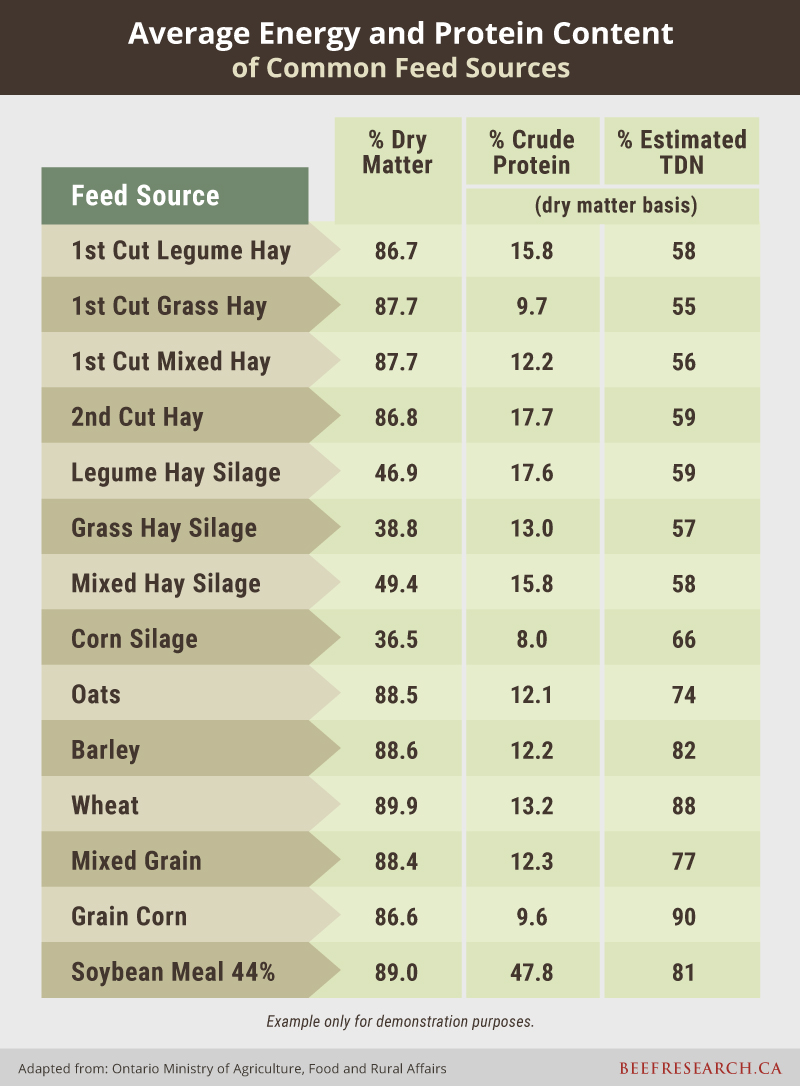
Click to enlarge
The level of minerals in a forage will depend on many factors including soil type, plant species, stage of growth, the conditions, and overall management of the stand. Maturity at harvest, as well as harvest techniques and storage will also bear on forage quality. In addition, the absorption of trace minerals from forages in the alimentary canal can be very depression. As Dr. John McKinnon explains in this web log, antagonistic interactions betwixt minerals tin reduce levels absorbed fifty-fifty farther, sometimes even to zero.
Low quality forages generally reduce voluntary intake, which can result in protein and energy deficiencies. When high quality forage (vegetative growth) is consumed, dry affair intake tends to be 2.5-iii.0% of live torso weight. When forage is of lower quality, dry matter intake tin can drop closer to 1.8% of body weight, reducing protein, energy, and mineral consumed. In some instances, when the animal'southward needs are not existence met (due east.thousand. feeding a ration containing very low quality forages or straw during cold temperatures in winter), they may really over-consume low quality feed, as they endeavour to derive enough free energy from the feed. This over-consumption of bulky, low quality feed can cause compaction, which prevents feed from moving through the digestive tract and can cause death. Analyzing feed samples will provide an indication of poly peptide and energy levels bachelor. While feeding lower quality feedstuffs tin be an economical fashion to stretch feed supplies, producers must monitor consumption and animal condition to avoid potential issues with under or over consumption of low quality feed. Utilize of tools such every bit the Winter Feed Cost Comparison computer can assist producers with toll comparisons.
Cognition of forage quality and animal requirements is necessary to formulate rations that will support and maintain a high plane of nutrition. While most producers recognize that grazing forages can provide an economical source of nutrition, the human relationship between forage quality and profitability is often unappreciated. Producers must manage grazing in response to environmental conditions and pasture growth during the season to avoid either overgrazing, which reduces fodder yield, and nether grazing which tin can lower the overall fodder quality due to over-mature vegetation and may also increase forage waste. Proper grazing management can support both nutrition and profitability.
Factors Affecting Nutrient Requirements
Phase of Production
Nutritional requirements of beef cattle are influenced by the phase of production. This product cycle, which is based upon a well-managed, salubrious cow in skillful condition (Torso Condition Score = three) maximizes profitability by producing a calf every 365 days. The annual production cycle, based upon platonic length of time for each stage, includes:
- Calving, postpartum, early lactation (mean solar day 0 to day 82)
- Conception, early gestation, late lactation (day 83 to twenty-four hour period 199)
- Mid gestation (day 200 to day 274)
- Belatedly gestation, pre-partum (twenty-four hour period 275 to day 365).
Stage 1 - begins at calving. This is the catamenia of greatest nutritional demand for the moo-cow. She must lactate, repair her reproductive tract, resume heat cycles, breed, and if she is a immature cow, she must also continue growth and evolution. Her voluntary feed intake is highest at this point and as this web log explains, she requires a high energy and poly peptide diet of at least 62% TDN and eleven% CP. If she is not fed to meet nutritional needs, she will lose weight and may not rebreed.
Phase 2 - begins with conception. The cow is now supporting herself, her dogie (through lactation) and her fetus. Nutritional demands are yet loftier as she reaches peak lactation but are lowered by viii-13% compared to the outset phase. Cows that produce more milk volition have higher nutrient requirements. The fetus is small, and its growth is slow, but cows and heifers often lose weight during this time.
Phase three - is when the cow is in mid-gestation. Immediately after calves are weaned, nutritional needs are at their lowest due to the end of lactation. Energy and protein requirements driblet past up to 35% when compared to the peak need. Fetal growth remains slow, and voluntary feed intake is the lowest during this menstruation. This is the best time to put weight back on cows to help them gain condition10. See the body condition data to learn more about how to ensure beef cattle are in ideal status.
Phase 4 - is the last phase prior to calving, and cows must be in skilful body condition to give birth to a healthy calf, produce milk and re-breed chop-chop. Energy and protein needs increase past 20% compared to mid-gestation. During this flow, the fetus can gain up to threescore pounds and the placenta is growing besides. About 75% of fetal growth occurs during this stage11. Cows need to gain 0.5 kg (i lb) to 0.68 kg (1.five lbs) per day, while weight gain for heifers should target twice that amount. The cow has reduced rumen chapters due to the growth of the dogie, so a reduction in feed intake usually occurs in the latter portion of this stage.
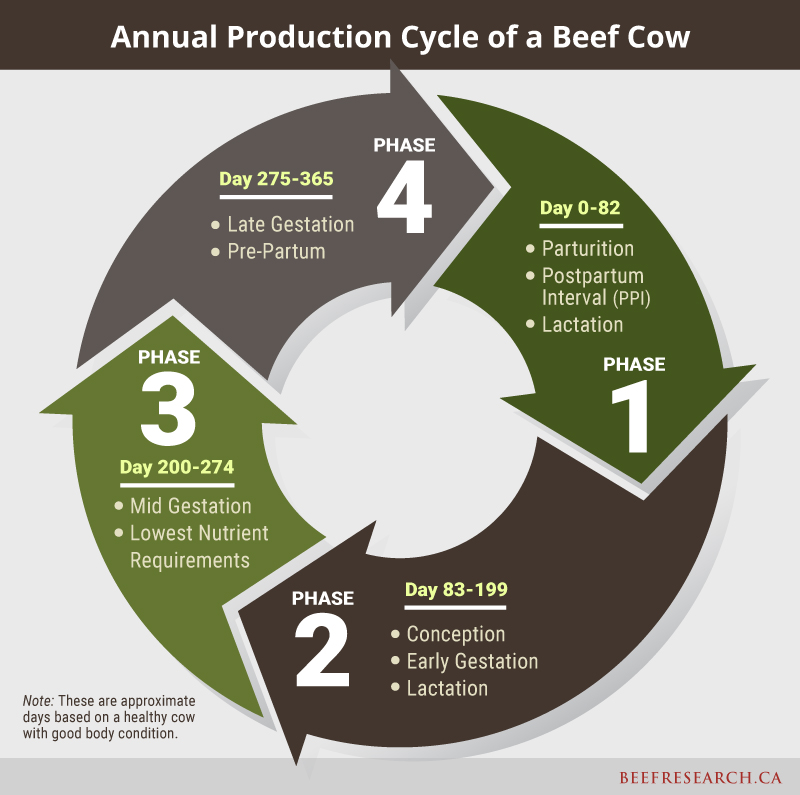
Click to enlarge
Producers frequently modify their feeding strategies during the annual production cycle of the beef cow to align with her energy and protein needs as she moves through the cycle. For example, lower quality feeds such equally straw reduce costs during Phase 3, when the cow's nutritional requirements are at her lowest. In Stage iv, every bit the rumen has less room for feed due to the growing fetus, she will do good from higher quality feed such as good quality alfalfa hay or some grain to provide extra free energy. A common rule of pollex is 55-60-65% for total digestible nutrients (TDN) and seven-9-11% for rough protein (CP) for mid gestation, late gestation, and lactation. More information on nutritional requirements can exist can be found here.
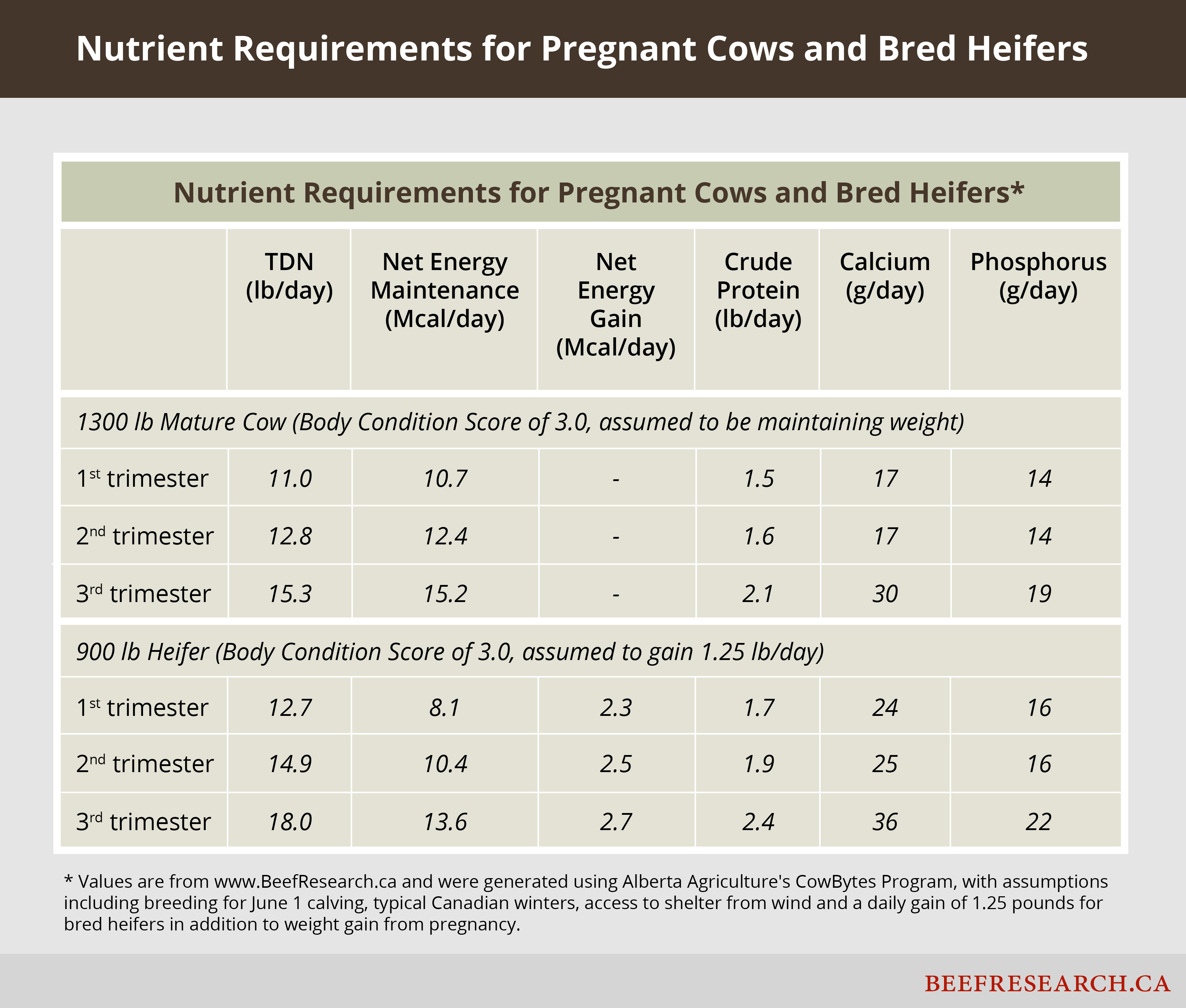
Click to enlarge
Producers often split the herd into different feeding groups to tailor the feeding program to provide an adequate level of nutrition. These groups may include:
Group 1 - Mature cows in adept condition - Average quality hay supplemented with grain or pellets, minerals, fortified salt and vitamins, will generally meet the nutritional needs of this grouping.
Group 2 - Bred replacement heifers and second calf heifers - Immature, growing animals exercise non compete finer for feed with mature cows. Heifers require proficient quality hay, silage or alternative feeds, or grain to see their needs for growth and evolution. These animals are still growing and gaining torso weight, in addition to developing the fetus. These animals may benefit from organic (chelated) or hydroxy trace mineral supplements, which have greater bioavailability, to back up growth and reproduction.
Group 3 - Sparse, old cows - These cows will need extra free energy, particularly during winter months. These cattle may do good from boosted vitamin and mineral programs to avoid deficiencies.
Group 4 - Yearling steers, bulls - Steers and bulls will require different feeding programs depending on their size and if they are on a maintenance plan or are backgrounding or finishing.
If the ration is based on straw or low-quality hay, or if feed intake is express, it is even more than of import to split up the herd into different feeding groups to lucifer the nutritional needs of each group. Utilize feed testing and ration balancing software like Cowbytes to determine the advisable ration and amounts of feed for each group.
Conclusion
Cattle crave free energy, protein, water, vitamins and minerals in adequate amounts for optimal nutrition. The requirements for these nutrients will vary depending upon the class, age, condition, and stage of production of the animate being. Environmental factors will besides influence beast diet and nutrient levels both in the feed and water sources. Feed costs represent the greatest expense associated with beef production. Nutrition is the most of import factor for cow fertility, which is a main driver of profitability. Supplemental vitamin and mineral programs can improve livestock health, immune function, functioning and fertility.
Each operation is unique; work with a nutritionist to identify and correct nutritional deficiencies early, before herd health and profitability is compromised. Place groups of cattle that may require boosted or customized feeding strategies. Feeding only depression-quality feedstuffs to relieve feed costs will generally increase reproductive losses, unless get-go by what is likely to be a more expensive supplementation program. A properly balanced ration will improve cattle performance, productivity and ultimately profitability.
Definitions
Acid detergent fibre (ADF) - a chemical analysis that estimates the total fibre (including indigestible lignin) in the feed. A loftier ADF indicates reduced digestibility and probable lower voluntary feed intake.
Amino acids - nitrogen-containing molecules that are the building blocks used to create poly peptide in the trunk.
Available protein - the portion of rough protein that can be digested by the animal. Information technology represents the proportion of total protein after deducting the ADF-N fraction of a feed.
Sugar - a source of dietary energy that includes starches, sugars, pectins, cellulose and hemicellulose. All carbohydrates incorporate carbon, hydrogen and oxygen, and are commonly divided into two types: structural (fibre from plant wall) and non-structural (sugars and starches from institute cell contents).
Cellulose - a fibrous sugar that is the main part of found cell walls.
Chelated mineral - a chemic bond formed between an organic molecule and a mineral that increases mineral bioavailability to the animal and can reduce excretion of backlog minerals in manure.
Rough protein (CP) - an estimate of the total protein content of a feed determined past analyzing the nitrogen content of the feed and multiplying the outcome by six.25. Crude poly peptide includes truthful poly peptide and non-protein nitrogen sources such as ammonia, amino acids and nitrates.
Digestible energy (DE) - the apparent energy that is available to the animal by digestion, measured as the difference between gross energy content of a feed and the energy contained in the animal's feces.
Fat soluble vitamins - stored in the animal's fat reserves or liver, including A, D, E, and Grand.
Hemicellulose - a sugar found in plant jail cell walls that is more circuitous in structure than sugars but less complex than cellulose.
International unit (IU) - a standard unit of authorisation of a biological agent, such as a vitamin, hormone, vaccine, or antibody.
Neutral detergent fibre (NDF) - an insoluble fraction containing all plant jail cell wall components left after boiling a feed sample in a neutral detergent solution. A high NDF indicates lower digestibility and voluntary feed intake.
Not-protein nitrogen (NPN) - urea and ammonia are compounds that can be used past the microorganisms in the rumen to course true protein, that can then exist converted to meat or milk by the animals. When feeding depression quality, low protein feeds, urea can help the ruminal bacteria to create truthful protein.
Non-structural saccharide - comprised of sugar, starch and pectin, this is the non-NDF fraction of feedstuffs.
Rumen degradable protein (RDP) - the portion of dietary protein that is degraded in the rumen. It feeds the rumen leaner, supplying microbial protein.
Rumen undegraded protein (RUP) - the portion of dietary protein that escapes degradation by ruminal microorganisms and passes into the small-scale intestine where information technology is digested and captivated.
Structural carbohydrate - the fibrous, cell wall or support structure of the found, containing cellulose, hemicellulose and lignin.
Water soluble vitamins - include the B complex vitamins and vitamin C. They are generally not supplemented to cattle after two months of age, due to the power of rumen microbes to manufacture them in adequate amounts12.
This topic was final revised on March 23, 2022 at 7:53 AM.
pattersongived1963.blogspot.com
Source: https://www.beefresearch.ca/research-topic.cfm/beef-cattle-nutrition-107
Post a Comment for "Beef Cattle Feed Requirements Beef Cattle Feed Requirements 6 Months"